Urbanisation-Induced Land Cover Temperature Dynamics for Sustainable Future Urban Heat Island Mitigation
Abstract
:1. Introduction
2. Study Area
3. Data and Methodology
3.1. Land Cover Data
3.2. MODIS Temperature Data
3.3. Establishing a UHI Effect
4. Results
4.1. Spatial and Temporal Dynamics of UHI
4.1.1. Land Cover and LST
4.1.2. Temporality of the SUHII
4.1.3. Spatiality of the SUHII
4.2. Land Cover Change and LST
5. Discussion
6. Conclusions
Supplementary Materials
Acknowledgments
Author Contributions
Conflicts of Interest
References
- United Nations, Department of Economic and Social Affairs. World Urbanization Prospects: The 2014 Revision, Highlights. 2014. Available online: https://esa.un.org/unpd/wup/publications/files/wup2014-report.pdf (accessed on 1 December 2017).
- United Nations. The World’s Cities in 2016: Data Booklet. 2016. Available online: http://www.un.org/en/development/desa/population/publications/pdf/urbanization/the_worlds_cities_in_2016_data_booklet.pdf (accessed on 1 December 2017).
- Seto, K.C.; Güneralp, B.; Hutyra, L.R. Global forecasts of urban expansion to 2030 and direct impacts on biodiversity and carbon pools. Proc. Natl. Acad. Sci. USA 2012, 109, 16083–16088. [Google Scholar] [CrossRef] [PubMed]
- Angel, S.; Parent, J.; Civco, D.L.; Blei, A.; Potere, D. The dimensions of global urban expansion: Estimates and projections for all countries, 2000–2050. Prog. Plan. 2011, 75, 53–107. [Google Scholar] [CrossRef]
- Zhou, D.; Zhang, L.; Hao, L.; Sun, G.; Liu, Y.; Zhu, C. Spatiotemporal trends of urban heat island effect along the urban development intensity gradient in China. Sci. Total Environ. 2016, 544, 617–626. [Google Scholar] [CrossRef] [PubMed]
- Cai, Y.; Zhang, H.; Zheng, P.; Pan, W. Quantifying the Impact of Land use/Land Cover Changes on the Urban Heat Island: A Case Study of the Natural Wetlands Distribution Area of Fuzhou City, China. Wetlands 2016, 36, 285–298. [Google Scholar] [CrossRef]
- Howard, L. The Climate of London; Cambridge University Press: London, UK, 1988. [Google Scholar]
- Hu, L.; Brunsell, N.A. A new perspective to assess the urban heat island through remotely sensed atmospheric profiles. Remote Sens. Environ. 2015, 158, 393–406. [Google Scholar] [CrossRef]
- Xie, Q.; Zhou, Z. Impact of Urbanization on Urban Heat Island Effect Based on TM Imagery in Wuhan, China. Environ. Eng. Manag. J. 2015, 14, 647–655. [Google Scholar]
- MacLachlan, A.; Biggs, E.; Roberts, G.; Boruff, B. Urban Growth Dynamics in Perth, Western Australia: Using Applied Remote Sensing for Sustainable Future Planning. Land 2017, 6, 9. [Google Scholar] [CrossRef]
- Rizwan, A.M.; Dennis, L.Y.C.; Liu, C. A review on the generation, determination and mitigation of Urban Heat Island. J. Environ. Sci. 2008, 20, 120–128. [Google Scholar] [CrossRef]
- Revi, A.; Satterthwaite, D.E.; Aragón-Durand, F.; Corfee-Morlot, J.; Kiunsi, R.; Pelling, M.; Roberts, D.; Solecki, W. Climate Change 2014: Impacts, Adaptation, and Vulnerability. Part A: Global and Sectoral Aspects. Contribution of Working Group II to the Fifth Assessment Report of the Intergovernmental Panel on Climate Change. 2014. Available online: https://kclpure.kcl.ac.uk/portal/en/publications/towards-transformative-adaptation-in-cities%280fabac74-a5fc-4956-b551-f9d391ec363c%29/export.html (accessed on 1 December 2017).
- Yuan, F.; Bauer, M.E. Comparison of impervious surface area and normalized difference vegetation index as indicators of surface urban heat island effects in Landsat imagery. Remote Sens. Environ. 2007, 106, 375–386. [Google Scholar] [CrossRef]
- Schwarz, N.; Schlink, U.; Franck, U.; Großmann, K. Relationship of land surface and air temperatures and its implications for quantifying urban heat island indicators—An application for the city of Leipzig (Germany). Ecol. Indic. 2012, 18, 693–704. [Google Scholar] [CrossRef]
- Goggins, W.B.; Chan, E.Y.Y.; Ng, E.; Ren, C.; Chen, L. Effect modification of the association between short-term meteorological factors and mortality by urban heat islands in Hong Kong. PLoS ONE 2012, 7, e38551. [Google Scholar] [CrossRef] [PubMed]
- Smargiassi, A.; Goldberg, M.S.; Plante, C.; Fournier, M.; Baudouin, Y.; Kosatsky, T. Variation of daily warm season mortality as a function of micro-urban heat islands. J. Epidemiol. Commun. Health 2009, 63, 659–664. [Google Scholar] [CrossRef] [PubMed]
- Lowe, S.A. An energy and mortality impact assessment of the urban heat island in the US. Environ. Impact Assess. Rev. 2016, 56, 139–144. [Google Scholar] [CrossRef]
- Guhathakurta, S.; Gober, P. The impact of the Phoenix Urban Heat Island on residential water use. J. Am. Plan. Assoc. Am. Plan. Assoc. Chicagti. 2007, 73, 317–329. [Google Scholar] [CrossRef]
- AECOM Australia. Economic Assessment of the Urban Heat Island Effect. 2012. Available online: https://www.melbourne.vic.gov.au/SiteCollectionDocuments/eco-assessment-of-urban-heat-island-effect.pdf (accessed on 1 December 2017).
- Mayor of London. London’s Response to Climate Change. 2016. Available online: https://www.london.gov.uk/what-we-do/planning/london-plan/current-london-plan/london-plan-chapter-five-londons-response (accessed on 1 December 2017).
- Mayor Bill de Blasio. Transforming New York City’s Buildings for a Low-Carbon Future. 2014. Available online: https://www1.nyc.gov/assets/sustainability/downloads/pdf/publications/TWGreport_04212016.pdf (accessed on 1 December 2017).
- Governor of Tokyo. Tokyo Metropolitan Environmental Master Plan. 2008. Available online: https://www.kankyo.metro.tokyo.jp/en/attachement/Master-Plan%28Outline%29.pdf (accessed on 1 December 2017).
- C40 Cities. Good Practice Guide: Cool Cities. Available online: http://c40-production-images.s3.amazonaws.com/good_practice_briefings/images/4_C40_GPG_CCN.original.pdf?1456788797 (accessed on 1 December 2017).
- C40Cities. Climate Action in Megacities: C40 Cities Baseline and Opportunities; ARUP: London, UK, 2011. [Google Scholar]
- Cheval, S.; Dumitrescu, A. The summer surface urban heat island of Bucharest (Romania) retrieved from MODIS images. Theor. Appl. Climatol. 2014, 631–640. [Google Scholar] [CrossRef]
- Hu, Y.; Jia, G.; Hou, M.; Zhang, X.; Zheng, F.; Liu, Y. The cumulative effects of urban expansion on land surface temperatures in metropolitan Jingjintang, China Yonghong. J. Geophys. Res. Atmos. Res. 2015, 9932–9943. [Google Scholar] [CrossRef]
- Tran, H.; Uchihama, D.; Ochi, S.; Yasuoka, Y. Assessment with satellite data of the urban heat island effects in Asian mega cities. Int. J. Appl. Earth Obs. Geoinf. 2006, 8, 34–48. [Google Scholar] [CrossRef]
- Fabrizi, R.; Bonafoni, S.; Biondi, R. Satellite and ground-based sensors for the Urban Heat Island analysis in the city of Rome. Remote Sens. 2010, 2, 1400–1415. [Google Scholar] [CrossRef]
- Sheng, L.; Lu, D.; Huang, J. Impacts of land-cover types on an urban heat island in Hangzhou, China. Int. J. Remote Sens. 2015, 36, 1584–1603. [Google Scholar] [CrossRef]
- Zhou, D.; Zhao, S.; Zhang, L.; Sun, G.; Liu, Y. The footprint of urban heat island effect in China. Nat. Sci. Reports 2015, 5, 11160–11171. [Google Scholar] [CrossRef] [PubMed]
- Kenward, A.; Yawitz, D.; Sanford, T. Slug Summer in the City: Hot and Getting Hotter. 2014. Available online: http://assets.climatecentral.org/pdfs/UrbanHeatIsland.pdf (accessed on 1 December 2017).
- Osborn, D.; Cutter, A.; Ullah, F. Universal Sustainable Development Goals: Understanding the Transformational Challenge for Developed Countries. 2015. Available online: https://sustainabledevelopment.un.org/content/documents/1684SF_-_SDG_Universality_Report_-_May_2015.pdf (accessed on 1 December 2017).
- The Rockefeller Foundation. City Resilience Framework—100 Resilient Cities; ARUP: New York, NY, USA, 2015. [Google Scholar]
- Bhatta, B. Analysis of Urban Growth and Sprawl from Remote Sensing Data; Springer: London, UK, 2010. [Google Scholar]
- Gallo, K.; Xian, G. Application of spatially gridded temperature and land cover data sets for urban heat island analysis. Urban Clim. 2014, 8, 1–10. [Google Scholar] [CrossRef]
- Guo, Y.; Gasparrini, A.; Armstrong, B.; Li, S.; Tawatsupa, B.; Tobias, A.; Lavigne, E.; De Sousa Zanotti Stagliorio Coelho, M.; Leone, M.; Pan, X.; et al. Global Variation in the Effects of Ambient Temperature on Mortality. Epidemiology 2014, 25, 781–789. [Google Scholar] [CrossRef] [PubMed]
- Tan, J.; Zheng, Y.; Tang, X.; Guo, C.; Li, L.; Song, G.; Zhen, X.; Yuan, D.; Kalkstein, A.J.; Li, F.; et al. The urban heat island and its impact on heat waves and human health in Shanghai. Int. J. Biometeorol. 2010, 54, 75–84. [Google Scholar] [CrossRef] [PubMed]
- Earl, N.; Simmonds, I.; Tapper, N. Weekly cycles in peak time temperatures and urban heat island intensity. Environ. Res. Lett. 2016, 11, 1–10. [Google Scholar] [CrossRef]
- Hattis, D.; Ogneva-Himmelberger, Y.; Ratick, S. The spatial variability of heat-related mortality in Massachusetts. Appl. Geogr. 2012, 33, 45–52. [Google Scholar] [CrossRef]
- Knight, S.; Smith, C.; Roberts, M. Mapping Manchester’s urban heat island. Weather 2010, 65, 188–193. [Google Scholar] [CrossRef]
- Giorgio, G.A.; Ragosta, M.; Telesca, V. Climate variability and industrial-suburban heat environment in a mediterranean area. Sustainability. 2017, 9, 775. [Google Scholar] [CrossRef]
- Wang, J.; Huang, B.; Fu, D.; Atkinson, P. Spatiotemporal Variation in Surface Urban Heat Island Intensity and Associated Determinants across Major Chinese Cities. Remote Sens. 2015, 7, 3670–3689. [Google Scholar] [CrossRef]
- Rinner, C.; Hussain, M. Toronto’s urban heat island-exploring the relationship between land use and surface temperature. Remote Sens. 2011, 3, 1251–1265. [Google Scholar] [CrossRef]
- Sobrino, J.A.; Jiménez-Muñoz, J.C.; Paolini, L. Land surface temperature retrieval from LANDSAT TM 5. Remote Sens. Environ. 2004, 90, 434–440. [Google Scholar] [CrossRef]
- Jimenez-Munoz, J.C.; Sobrino, J.A.; Skokovic, D.; Mattar, C.; Cristobal, J. Land surface temperature retrieval methods from Landsat-8 thermal infrared sensor data. IEEE Geosci. Remote Sens. Lett. 2014, 11, 1840–1843. [Google Scholar] [CrossRef]
- Blasi, M.G.; Liuzzi, G.; Masiello, G.; Serio, C.; Telesca, V.; Venafra, S. Surface parameters from seviri observations through a kalman filter approach: Application and evaluation of the scheme to the southern Italy. Tethys 2016, 2016, 1–19. [Google Scholar] [CrossRef]
- Kim, D.-Y.; Han, K.-S. Remotely sensed retrieval of midday air temperature considering atmospheric and surface moisture conditions. Int. J. Remote Sens. 2013, 34, 247–263. [Google Scholar] [CrossRef]
- Imhoff, M.L.; Zhang, P.; Wolfe, R.E.; Bounoua, L. Remote sensing of the urban heat island effect across biomes in the continental USA. Remote Sens. Environ. 2010, 114, 504–513. [Google Scholar] [CrossRef]
- Tomlinson, C.J.; Chapman, L.; Thornes, J.E.; Baker, C.J. Derivation of Birmingham’s summer surface urban heat island from MODIS satellite images. Int. J. Climatol. 2012, 32, 214–224. [Google Scholar] [CrossRef]
- Li, J.; Song, C.; Cao, L.; Zhu, F.; Meng, X.; Wu, J. Impacts of landscape structure on surface urban heat islands: A case study of Shanghai, China. Remote Sens. Environ. 2011, 115, 3249–3263. [Google Scholar] [CrossRef]
- Cao, X.; Onishi, A.; Chen, J.; Imura, H. Quantifying the cool island intensity of urban parks using ASTER and IKONOS data. Landsc. Urban Plan. 2010, 96, 224–231. [Google Scholar] [CrossRef]
- Kikon, N.; Singh, P.; Singh, S.K.; Vyas, A. Assessment of urban heat islands (UHI) of Noida City, India using multi-temporal satellite data. Sustain. Cities Soc. 2016, 22, 19–28. [Google Scholar] [CrossRef]
- Zhou, D.; Zhao, S.; Liu, S.; Zhang, L.; Zhu, C. Surface urban heat island in China’s 32 major cities: Spatial patterns and drivers. Remote Sens. Environ. 2014, 152, 51–61. [Google Scholar] [CrossRef]
- Zhang, H.; Qi, Z.F.; Ye, X.Y.; Cai, Y.B.; Ma, W.C.; Chen, M.N. Analysis of land use/land cover change, population shift, and their effects on spatiotemporal patterns of urban heat islands in metropolitan Shanghai, China. Appl. Geogr. 2013, 44, 121–133. [Google Scholar] [CrossRef]
- Zhao, G.; Dong, J.; Liu, J.; Zhai, J.; Cui, Y.; He, T.; Xiao, X. Different Patterns in Daytime and Nighttime Thermal Effects of Urbanization in Beijing-Tianjin-Hebei Urban Agglomeration. Remote Sens. 2017, 9, 121. [Google Scholar] [CrossRef]
- Xie, Q.; Zhou, Z.; Teng, M.; Wang, P. A multi-temporal Landsat TM data analysis of the impact of land use and land cover changes on the urban heat island effect. J. Food Agric. Environ. 2012, 10, 22–25. [Google Scholar]
- Deilami, K.; Kamruzzaman, M.; Hayes, J. Correlation or Causality between Land Cover Patterns and the Urban Heat Island Effect? Evidence from Brisbane, Australia. Remote Sens. 2016, 8, 716. [Google Scholar] [CrossRef]
- Kelly, J.F.; Weidmann, B.; Walsh, M. The Housing We’d Choose. 2011. Available online: https://grattan.edu.au/wp-content/uploads/2014/04/090_cities_report_housing_market.pdf (accessed on 1 December 2017).
- U.S. Department of Commerce. 2013 Housing Profile: United States; U.S. Census Bureau: Washinton, DC, USA, 2013.
- Australian National Accounts 1988–2015; ABS: Belconnen, ACT, Australia, 2015.
- Dhakal, S.P. Glimpses of Sustainability in Perth. Western Australia: Capturing and Communicating the Adaptive Capacity of an Activist Group. Cons. J. Sustain. Dev. 2014, 11, 167–182. [Google Scholar]
- Perth and Peel @ 3.5 Million; Western Australian Planning Commission: Perth, Australia, 2015.
- Boland, J.; Philipp, C. Monitoring the Urban Climatic Trends and Impacts; Urban Climates Research: Adelaide, Australia, 2013. [Google Scholar]
- Department of Mines and Petroleum. Western Australian Mineral and Petroleum Statistics Digest 1984–2015; Government of Western Australia: Perth, Australia, 2015; pp. 1984–2015.
- MacLachlan, A.; Biggs, E.; Roberts, G.; Boruff, B. Classified earth observation data between 1990 and 2015 for the Perth Metropolitan Region, Western Australia using the Import Vector Machine algorithm. 2017. [Google Scholar]
- Zhang, P.; Imhoff, M.L.; Bounoua, L.; Wolfe, R.E. Exploring the influence of impervious surface density and shape on urban heat islands in the northeast United States using MODIS and Landsat. Can. J. Remote Sens. 2012, 38, 441–451. [Google Scholar]
- Wan, Z. MODIS Land Surface Temperature Products Users’ Guide; University of California: Santa Barbara, CA, USA, 2006. [Google Scholar]
- Fu, P.; Weng, Q. Consistent land surface temperature data generation from irregularly spaced Landsat imagery. Remote Sens. Environ. 2016, 184, 175–187. [Google Scholar] [CrossRef]
- Wan, Z. New refinements and validation of the collection-6 MODIS land-surface temperature/emissivity product. Remote Sens. Environ. 2013, 140, 36–45. [Google Scholar] [CrossRef]
- Li, Y.; Zhang, H.; Kainz, W. Monitoring patterns of urban heat islands of the fast-growing Shanghai metropolis, China: Using time-series of Landsat TM/ETM+ data. Int. J. Appl. Earth Obs. Geoinf. 2012, 19, 127–138. [Google Scholar] [CrossRef]
- Haashemi, S.; Weng, Q.; Darvishi, A.; Alavipanah, S. Seasonal Variations of the Surface Urban Heat Island in a Semi-Arid City. Remote Sens. 2016, 8, 352. [Google Scholar] [CrossRef]
- Smith, S.W. The Scientist and Engineer’s Guide to Digital Singal Procssing; California Technical Publishing: San Diego, CA, USA, 2003. [Google Scholar]
- MacLachlan, A.; Roberts, G.; Biggs, E.; Boruff, B. Subpixel land-cover classification for improved urban area estimates using Landsat. Int. J. Remote Sens. 2017, 38, 5763–5792. [Google Scholar] [CrossRef]
- Kennewell, C.; Shaw, B.J. Perth, Western Australia. Cities 2008, 25, 243–255. [Google Scholar] [CrossRef]
- Oke, T.R. The energetic basis of the urban heat island. Q. J. R. Meteorol. Soc. 1982, 108, 1–24. [Google Scholar] [CrossRef]
- Xu, D.; Chen, R. Comparison of urban heat island and urban reflection in Nanjing City of China. Sustain. Cities Soc. 2017, 31, 26–36. [Google Scholar] [CrossRef]
- Daley, M.J.; Phillips, N.G. Interspecific variation in nighttime transpiration and stomatal conductance in a mixed New England deciduous forest. Tree Physiol. 2006, 26, 411–419. [Google Scholar] [CrossRef] [PubMed]
- Weng, Q.; Lu, D.; Schubring, J. Estimation of land surface temperature-vegetation abundance relationship for urban heat island studies. Remote Sens. Environ. 2004, 89, 467–483. [Google Scholar] [CrossRef]
- Zhao, S.; Zhou, D.; Liu, S. Data concurrency is required for estimating urban heat island intensity. Environ. Pollut. 2016, 208, 118–124. [Google Scholar] [CrossRef] [PubMed]
- Sharifi, E.; Lehmann, S. Comparative Analysis of Surface Urban Heat Island Effect in Central Sydney. J. Sustain. Dev. 2014, 7, 23–34. [Google Scholar] [CrossRef]
- Peng, S.; Piao, S.; Ciais, P.; Friedlingstein, P.; Ottle, C.; Bréon, F.-M.; Nan, H.; Zhou, L.; Myneni, R.B. Surface urban heat island across 419 global big cities. Environ. Sci. Technol. 2012, 46, 696–703. [Google Scholar] [CrossRef] [PubMed]
- Shen, H.; Huang, L.; Zhang, L.; Wu, P.; Zeng, C. Long-term and fine-scale satellite monitoring of the urban heat island effect by the fusion of multi-temporal and multi-sensor remote sensed data: A 26-year case study of the city of Wuhan in China. Remote Sens. Environ. 2016, 172, 109–125. [Google Scholar] [CrossRef]
- Shastri, H.; Barik, B.; Ghosh, S.; Venkataraman, C.; Sadavarte, P. Flip flop of Day-night and Summer-Winter Surface Urban Heat Island Intensity in India. Sci. Rep. 2017, 7, 1–8. [Google Scholar] [CrossRef] [PubMed]
- Orru, H.; Andersson, C.; Ebi, K.L.; Langner, J.; Åström, C.; Forsberg, B. Impact of climate change on ozone-related mortality and morbidity in Europe. Eur. Respir. J. 2013, 41, 285–294. [Google Scholar] [CrossRef] [PubMed]
- Environment Protection Agency. Reducing Urban Heat Islands: Compendium of Strategies—Urban Heat Island Basics; U.S. Environmental Protection Agency: Washington, CO, USA, 2012.
- Burnett, R.T.; Brook, J.R.; Yung, W.T.; Dales, R.E.; Krewski, D. Association between ozone and hospitalization for respiratory diseases in 16 Canadian cities. Environ. Res. 1997, 72, 24–31. [Google Scholar] [CrossRef] [PubMed]
- Szyszkowicz, M.; Rowe, B.H. Respiratory Health Conditions and Ambient Ozone: A Case-Crossover Study Insights in Chest Diseases. iMedPub J. 2016, 1, 1–5. [Google Scholar]
- Goudarzi, G.; Geravandi, S.; Foruozandeh, H.; Babaei, A.A.; Alavi, N.; Niri, M.V.; Khodayar, M.J.; Salmanzadeh, S.; Mohammadi, M.J. Cardiovascular and respiratory mortality attributed to ground-level ozone in Ahvaz, Iran. Environ. Monit. Assess. 2015, 187, 487–498. [Google Scholar] [CrossRef] [PubMed]
- Coutts, A.M.; Harris, R.J.; Phan, T.; Livesley, S.J.; Williams, N.S.G.; Tapper, N.J. Thermal infrared remote sensing of urban heat: Hotspots, vegetation, and an assessment of techniques for use in urban planning. Remote Sens. Environ. 2016, 186, 637–651. [Google Scholar] [CrossRef]
- Directions 2031 and beyond: Metropolitan Planning beyond the Horizon; Western Australian Planning Commission: Perth, Australia, 2010.
- Central Sub-Regional Planning Framework; Western Australian Planning Commission: Perth, Australia, 2015.
- North-West Sub-Regional Planning Framework; Western Australian Planning Commission: Perth, WA, Australia, 2015.
- North-East Sub-Regional Planning Framework; Western Australian Planning Commission: Perth, WA, Australia, 2015.
- South Metropolitan Peel Planning Framework; Western Australian Planning Commission: Perth, WA, Australia, 2015.
- Marfai, M.A.; Sekaranom, A.B.; Ward, P. Community responses and adaptation strategies toward flood hazard in Jakarta, Indonesia. Nat. Hazards 2014, 75, 1127–1144. [Google Scholar] [CrossRef]
- Suryahadi, A.; Sumarto, S. Poverty and Vulnerability in Indonesia before and after the Economic Crisis. Asian Econ. J. 2003, 17, 45–64. [Google Scholar] [CrossRef]
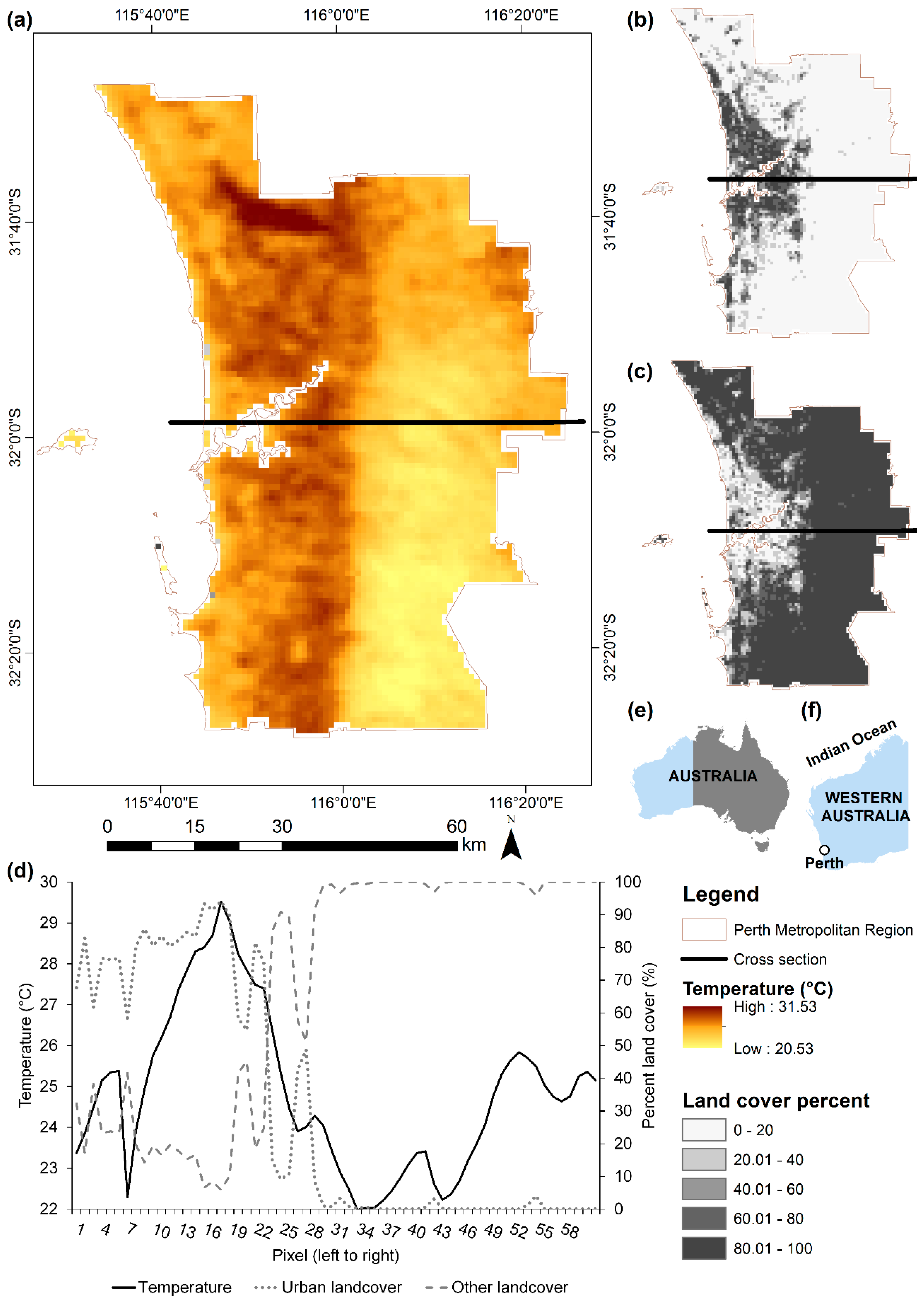
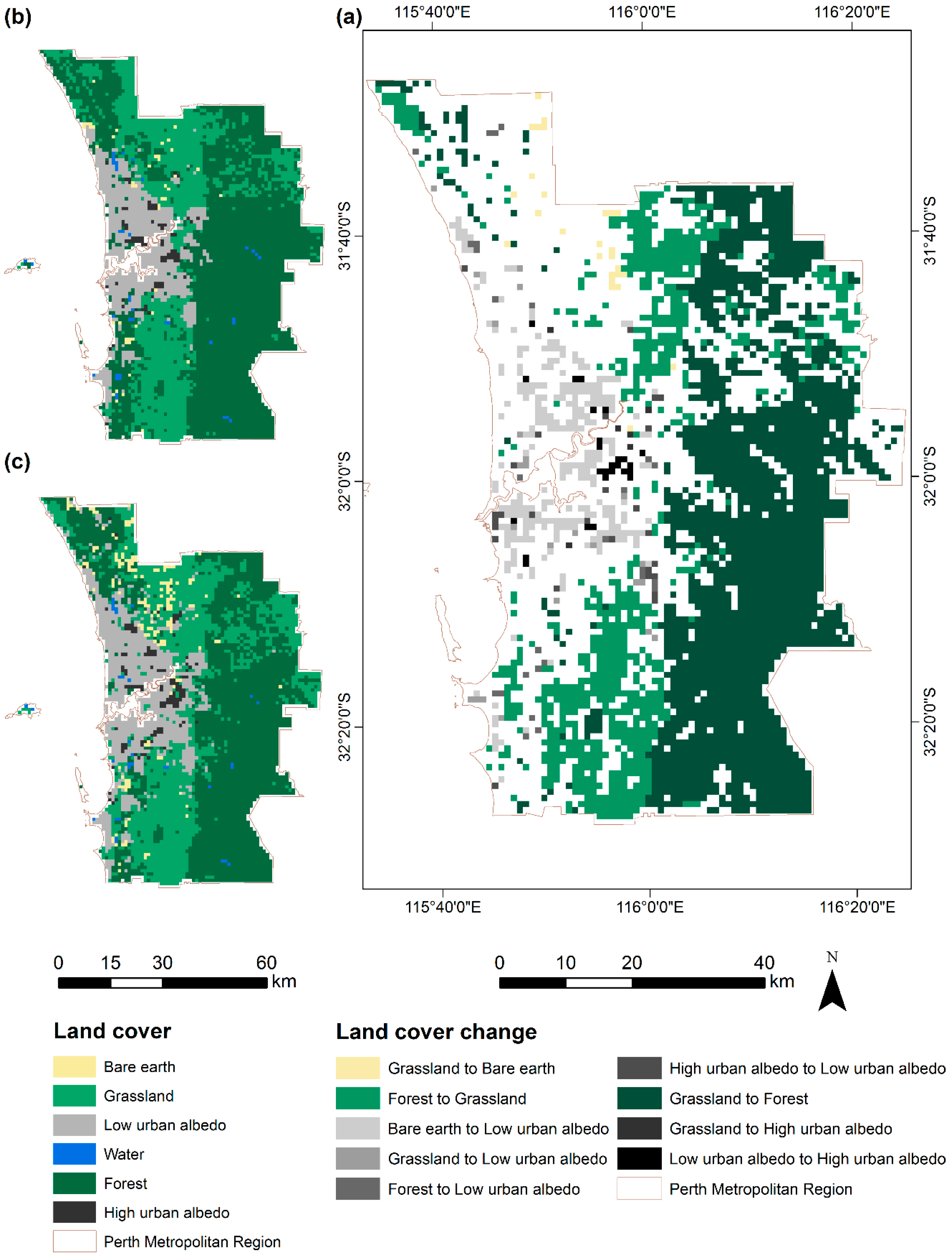
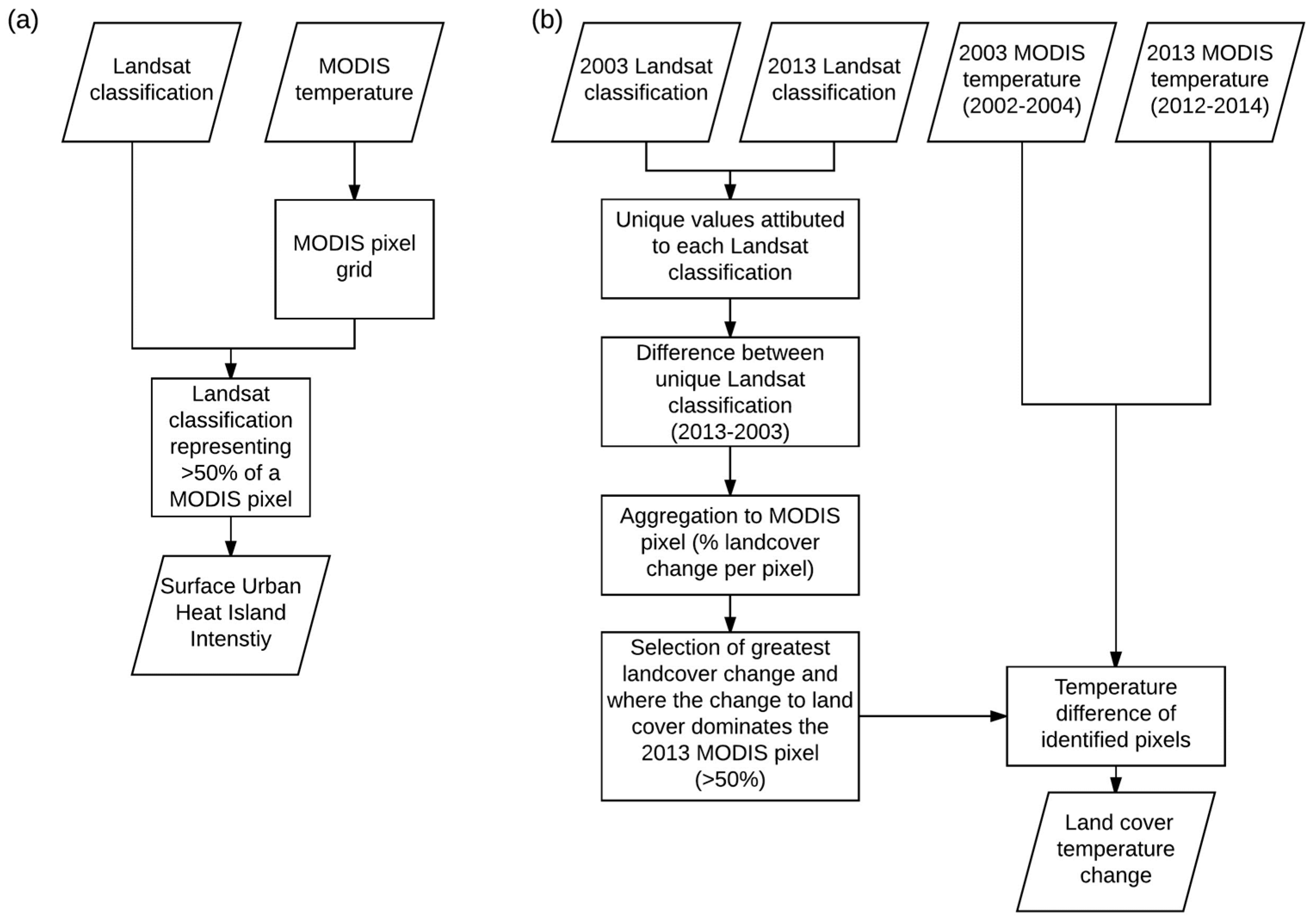
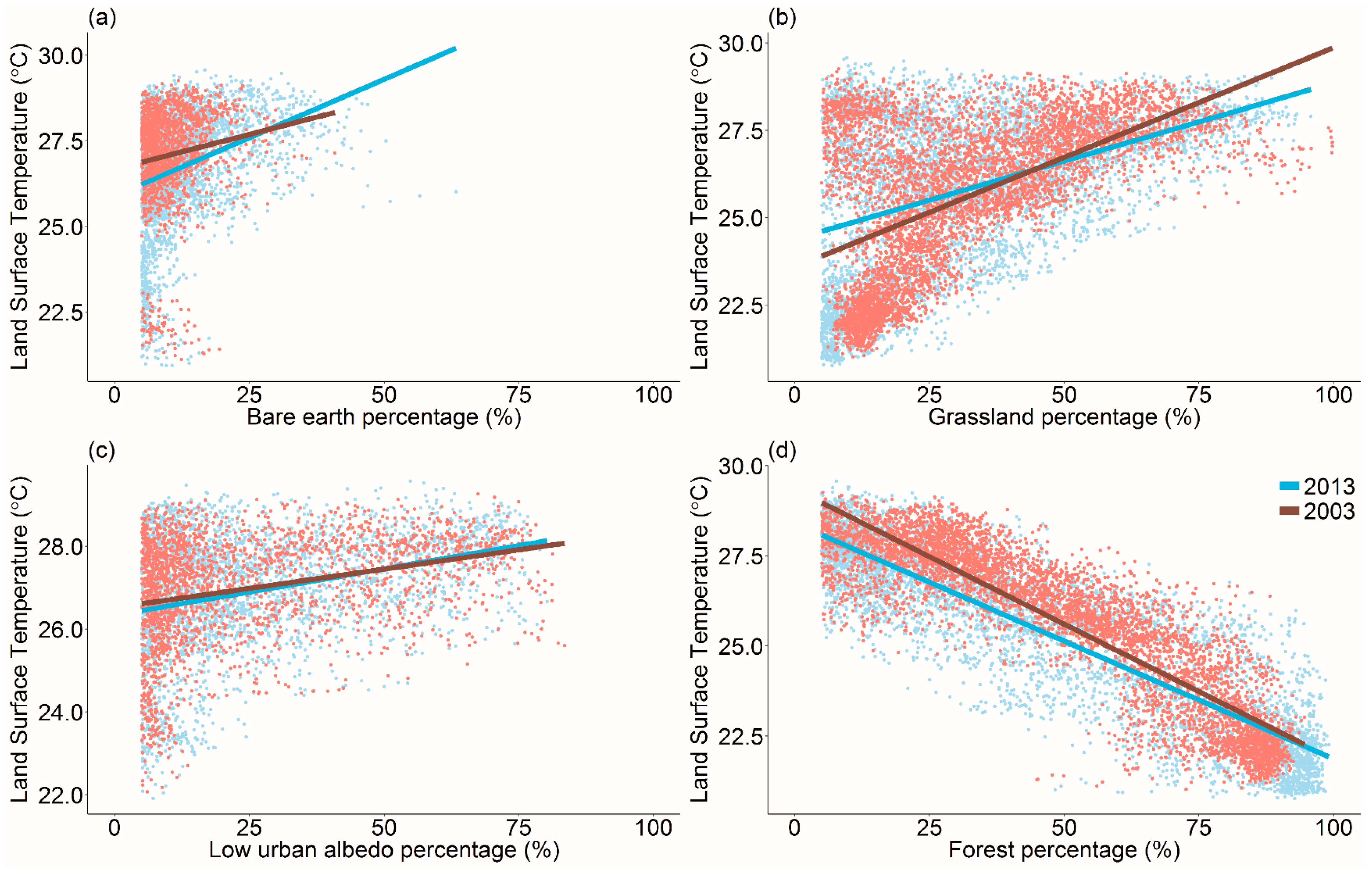
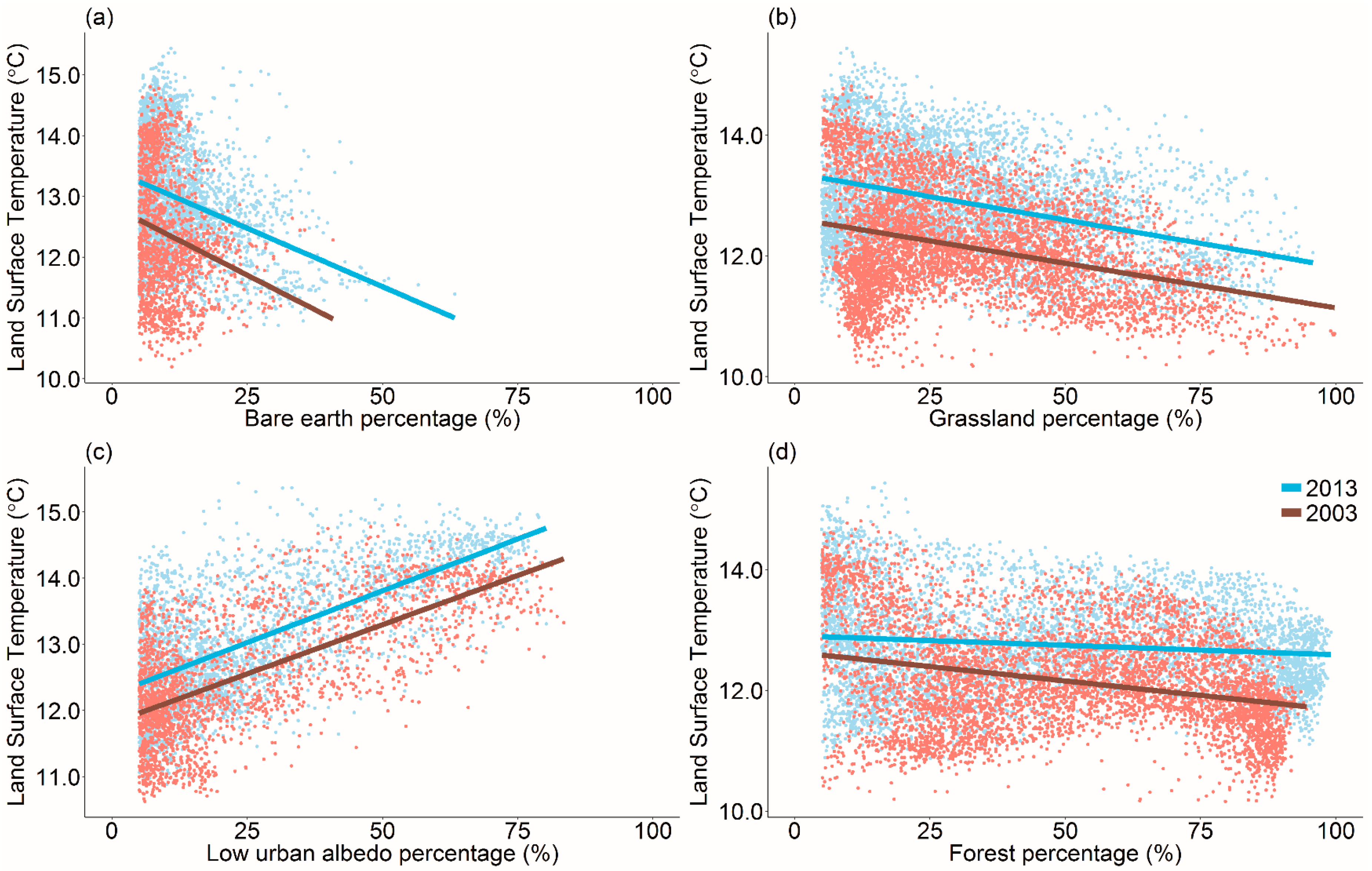
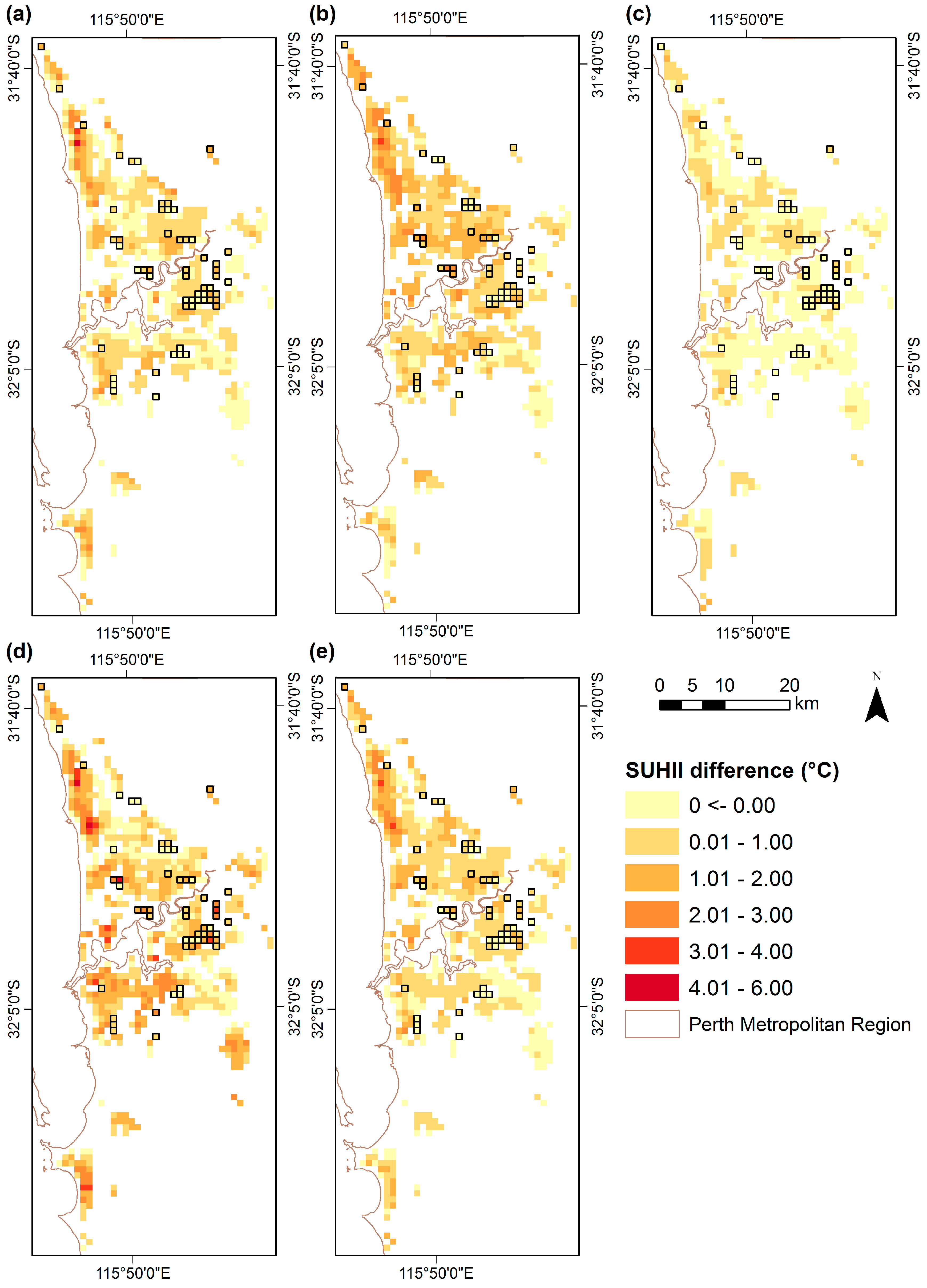
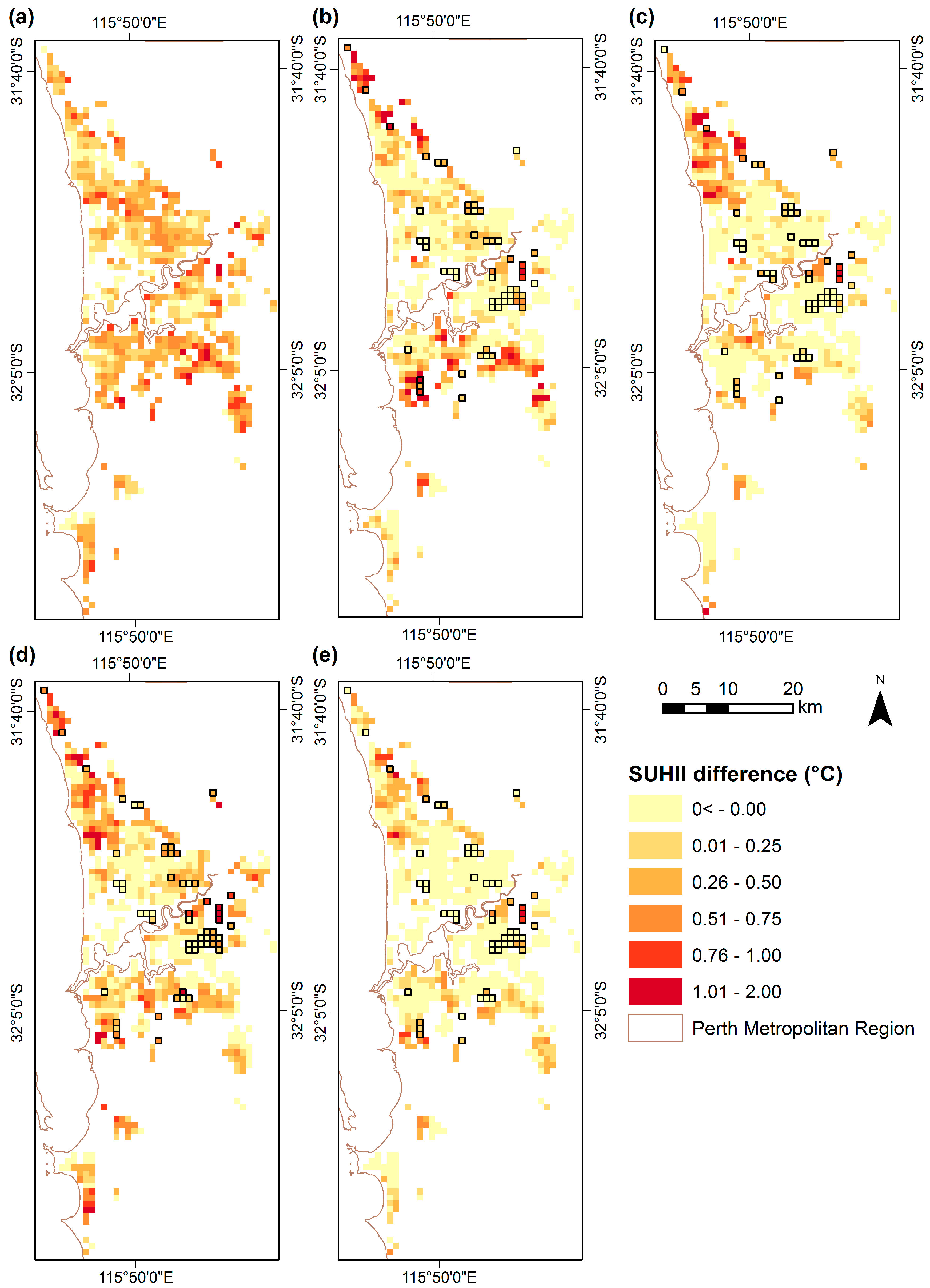
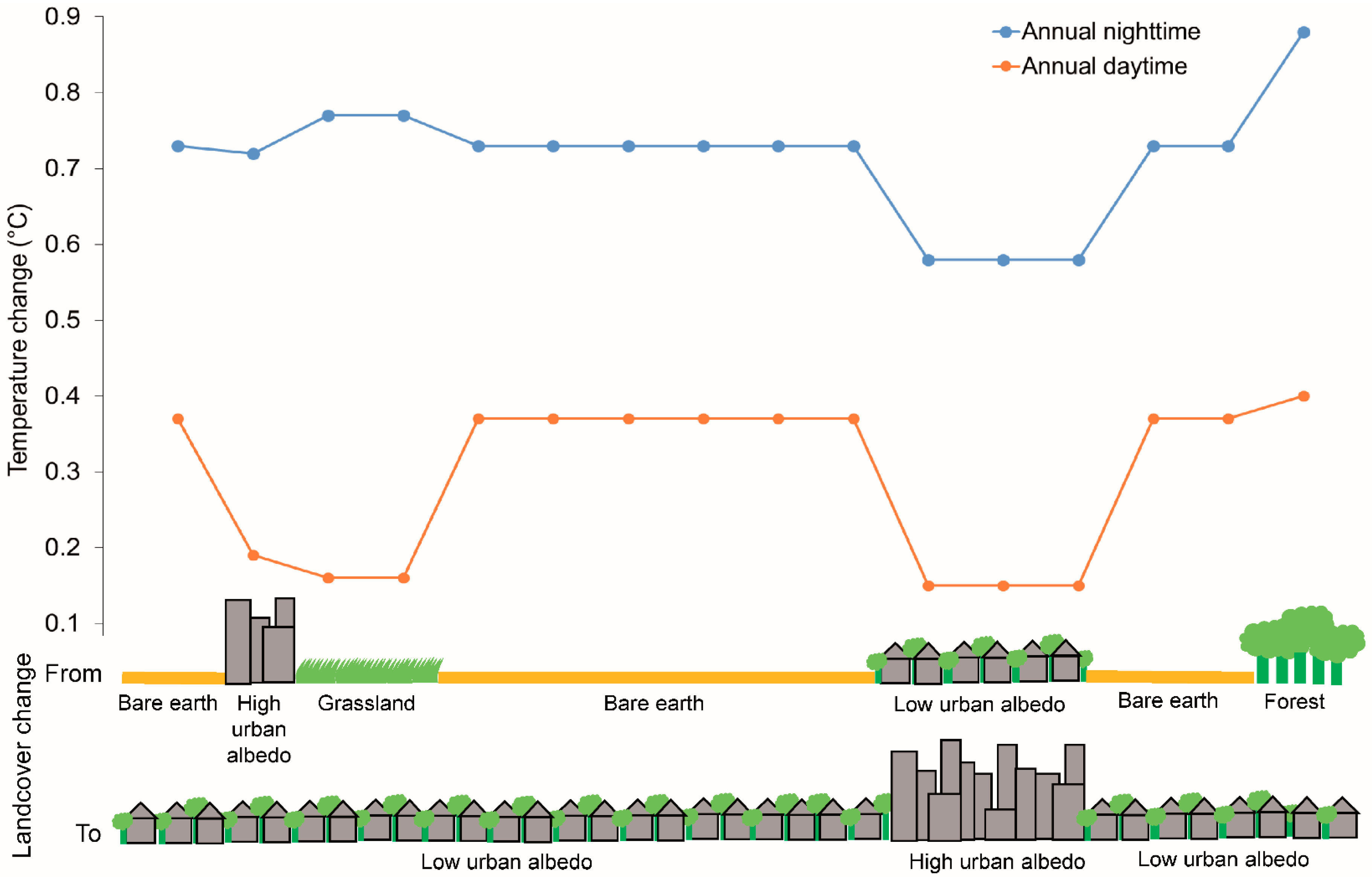
| Time of Day | Season | Year | UL vs. BE (°C) | UL vs. G (°C) | UL vs. W (°C) | UL vs. F (°C) | UL vs. UH (°C) | U vs. F (°C) |
|---|---|---|---|---|---|---|---|---|
| Day time | Summer | 2003 | −0.29 (1.94) | −2.81 (1.94) | 3.26 (1.94) | 3.50 (1.94) | −1.10 (1.94) | 3.56 (1.92) |
| 2013 | −1.74 (2.02) | −1.98 (2.02) | 4.21 (2.02) | 3.98 (2.02) | −1.22 (2.02) | 4.08 (2.01) | ||
| Autumn | 2003 | −0.26 (1.10) | −0.88 (1.10) | 1.10 (1.10) | 2.65 (1.10) | −0.56 (1.10) | 2.68 (1.09) | |
| 2013 | 0.06 (1.05) | −0.16 (1.05) | 1.91 (1.05) | 3.47 (1.05) | −0.36 (1.05) | 3.51 (1.03) | ||
| Winter | 2003 | 0.74 (0.66) | 1.06 (0.66) | 1.22 (0.66) | 2.79 (0.66) | −0.11 (0.66) | 2.78 (0.66) | |
| 2013 | 0.55 (0.62) | 0.91 (0.62) | 1.41 (0.62) | 2.66 (0.62) | 0.16 (0.62) | 2.65 (0.63) | ||
| Spring | 2003 | 0.93 (1.76) | 1.49 (1.76) | 3.50 (1.76) | 4.43 (1.76) | −1.49 (1.76) | 4.53 (1.77) | |
| 2013 | 0.55 (1.73) | 2.02 (1.73) | 4.49 (1.73) | 5.16 (1.73) | −1.28 (1.73) | 5.27 (1.75) | ||
| Annual | 2003 | 0.20 (1.30) | −0.15 (1.30) | 2.29 (1.30) | 3.32 (1.30) | −0.73 (1.30) | 3.36 (1.29) | |
| 2013 | −0.04 (1.28) | 0.36 (1.28) | 2.94 (1.28) | 3.86 (1.28) | −0.52 (1.28) | 3.91 (1.27) | ||
| Night time | Summer | 2003 | 1.23 (0.62) | 1.88 (0.62) | −0.13 (0.62) | 1.09 (0.62) | 0.07 (0.62) | 1.09 (0.63) |
| 2013 | 1.32 (0.64) | 1.73 (0.64) | 0.05 (0.64) | 1.31 (0.64) | 0.11 (0.64) | 1.30 (0.64) | ||
| Autumn | 2003 | 1.45 (0.75) | 1.88 (0.75) | 0.67 (0.75) | 1.44 (0.75) | 0.01 (0.75) | 1.44 (0.76) | |
| 2013 | 1.90 (0.69) | 1.87 (0.69) | 0.24 (0.69) | 1.44 (0.69) | 0.21 (0.69) | 1.42 (0.70) | ||
| Winter | 2003 | 1.05 (0.68) | 1.35 (0.68) | −0.47 (0.68) | 1.33 (0.68) | 0.21 (0.68) | 1.32 (0.69) | |
| 2013 | 1.58 (0.65) | 1.37 (0.65) | −0.31 (0.65) | 1.25 (0.65) | 0.43 (0.65) | 1.21 (0.66) | ||
| Spring | 2003 | 1.62 (0.73) | 2.09 (0.73) | −0.63 (0.73) | 1.76 (0.73) | 0.10 (0.73) | 1.76 (0.73) | |
| 2013 | 1.96 (0.73) | 1.75 (0.73) | −0.18 (0.73) | 1.82 (0.73) | 0.13 (0.73) | 1.81 (0.72) | ||
| Annual | 2003 | 1.49 (0.72) | 1.92 (0.72) | 0.01 (0.72) | 1.56 (0.72) | −0.06 (0.72) | 1.56 (0.73) | |
| 2013 | 1.94 (0.67) | 1.72 (0.67) | −0.12 (0.67) | 1.39 (0.67) | 0.16 (0.67) | 1.37 (0.67) |
| Time of Day | Season | F to UL (°C) | G to UL (°C) | BE to UL (°C) | UH to UL (°C) | F to G (°C) | G to F (°C) | G to BE (°C) | UL to UH (°C) | G to UH (°C) |
|---|---|---|---|---|---|---|---|---|---|---|
| Day | Summer | 0.13 | −0.14 | 0.31 | 0.11 | −0.55 | −0.17 | 0.05 | 0.20 | 0.00 |
| Autumn | 0.35 | 0.32 | 0.72 | 0.45 | 0.19 | −0.10 | 0.65 | 0.62 | 0.66 | |
| Winter | 0.58 | 0.46 | 0.44 | 0.41 | 0.51 | 0.40 | 0.42 | 0.35 | 0.19 | |
| Spring | 0.85 | 0.47 | 0.39 | 0.46 | 0.39 | 0.12 | 0.39 | 0.29 | 0.51 | |
| Annual | 0.40 | 0.16 | 0.37 | 0.19 | 0.08 | 0.00 | 0.44 | 0.15 | −0.02 | |
| Night | Summer | 1.09 | 1.09 | 1.03 | 1.06 | 0.94 | 0.92 | 0.95 | 0.86 | 0.90 |
| Autumn | 0.32 | 0.25 | 0.26 | 0.21 | 0.15 | 0.21 | 0.44 | 0.19 | 0.12 | |
| Winter | 0.54 | 0.45 | 0.27 | 0.38 | 0.24 | 0.65 | 0.18 | 0.09 | 0.04 | |
| Spring | 1.13 | 1.04 | 0.98 | 0.96 | 0.96 | 0.96 | 1.00 | 0.78 | 0.75 | |
| Annual | 0.88 | 0.77 | 0.73 | 0.72 | 0.70 | 0.80 | 0.80 | 0.58 | 0.47 |
© 2017 by the authors. Licensee MDPI, Basel, Switzerland. This article is an open access article distributed under the terms and conditions of the Creative Commons Attribution (CC BY) license (http://creativecommons.org/licenses/by/4.0/).
Share and Cite
MacLachlan, A.; Biggs, E.; Roberts, G.; Boruff, B. Urbanisation-Induced Land Cover Temperature Dynamics for Sustainable Future Urban Heat Island Mitigation. Urban Sci. 2017, 1, 38. https://doi.org/10.3390/urbansci1040038
MacLachlan A, Biggs E, Roberts G, Boruff B. Urbanisation-Induced Land Cover Temperature Dynamics for Sustainable Future Urban Heat Island Mitigation. Urban Science. 2017; 1(4):38. https://doi.org/10.3390/urbansci1040038
Chicago/Turabian StyleMacLachlan, Andrew, Eloise Biggs, Gareth Roberts, and Bryan Boruff. 2017. "Urbanisation-Induced Land Cover Temperature Dynamics for Sustainable Future Urban Heat Island Mitigation" Urban Science 1, no. 4: 38. https://doi.org/10.3390/urbansci1040038





